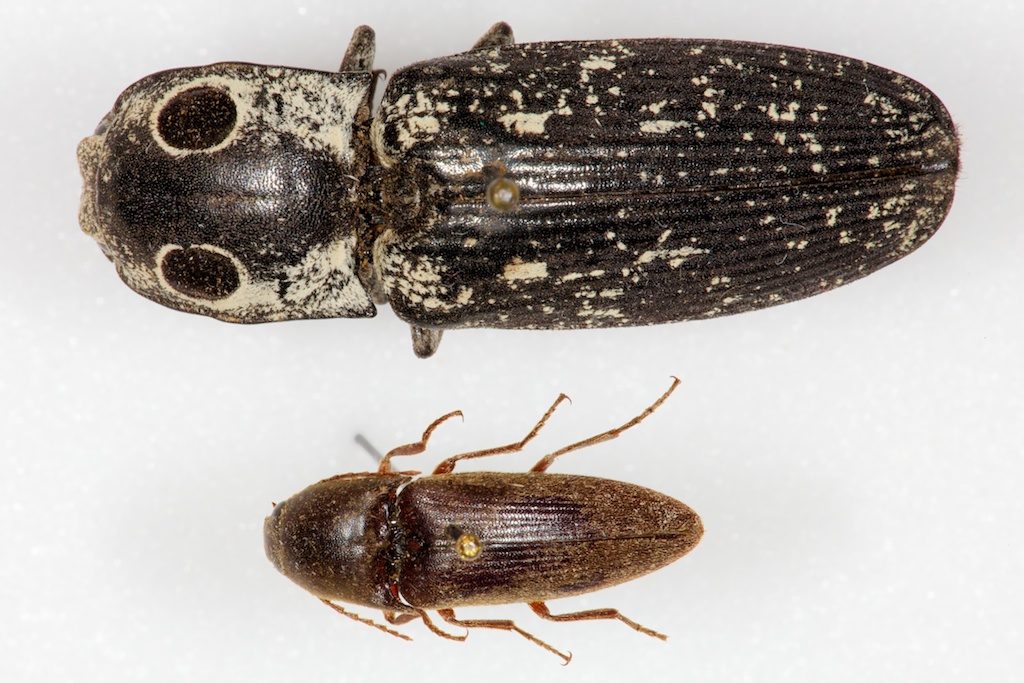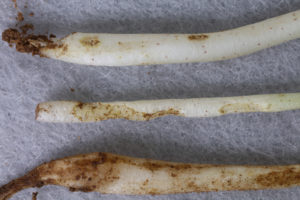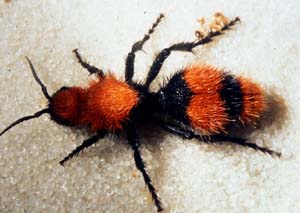Bastiaan M. Drees*
*Professor and Extension Entomologist, The Texas A&M University System.
Red harvester ants are one of the more noticeable and larger ants in open areas in Texas. Eleven species in this group of ants (genus Pogonomyrmex) are known from the state. However, harvester ants are not nearly as common today as they were during the earlier 1900s. The decline, particularly in the eastern part of the state, has caused some alarm because these ants serve as a major source of food for the rapidly disappearing and threatened Texas horned lizard.
Description

Red harvester ants
Worker ants are 1⁄4 to 1⁄2 inch long and red to dark brown. They have squarish heads and no spines on the body. There are 22 species of harvester ants in the United States, 10 of which are found in Texas. Seven of these species are found only in far west Texas.
Life cycle
Winged males and females swarm, couple and mate, especially following rains. Winged forms are larger than worker ants. Males soon die and females seek a suitable nesting site. After dropping her wings, the queen ant digs a burrow and produces a few eggs. Larvae hatch from eggs and develop through several stages (instars). Larvae are white and legless, shaped like a crookneck squash with a small distinct head. Pupation occurs within a cocoon. Worker ants produced by the queen ant begin caring for other developing ants, enlarge the nest and forage for food.
Pest status
Worker ants can give a painful, stinging bite, but are generally reluctant to attack. Effects of the bite can spread along lymph channels and can be medically serious. Harvester ant workers commonly are sold for ant farms.

Nest of red harvester ants
Habitat
Worker ants remove vegetation in circular areas or craters around nests. Colonies occur in open areas and usually have a single central opening. The area around the opening usually has small pebbles deposited on the soil surface by the worker ants. Often there is no vegetation within a 3- to 6-foot circle around the central opening of the colony, and along foraging trails radiating from the colony. Colonies usually are widely separated; however, heavy infestations in pasture and rangeland can reduce yield. Red harvester ants also colonize in ornamental turf areas where their presence may be undesirable. They do not invade homes or structures.
Food sources
Red harvester ant foragers collect seeds and dead insects and store them in the nests as food for the colony. The ants’ mouthparts are designed for chewing.
Management
Red harvester ants are native species and are generally not considered to be serious pests. Consider the option of not controlling these ants, especially in areas inhabited by the few remaining horned lizards (see box).
Help Save the Texas Horned Lizard
|
| The Texas horned lizard is a protected threatened species. It is commonly called “horny toad.”
Full-grown lizards are normally 2 1⁄2 to 4 1⁄4 inches from the snout to the tip of the tail, although some grow larger. They have broad, flattened bodies and bear a crown of spines at the back of the head. Their color varies by the background color of the habitat in which they live.
Populations of the horned lizard and the harvester ant, on which it predominantly feeds, have declined in the eastern part of Texas. There are several possible factors contributing to the decline of these species.
■ Red imported fire ants are believed to eliminate harvester ants and prevent new colonies from forming by preying on mated queen harvester ants.
■ Red imported fire ants may prey directly on lizards or on hatching eggs of lizards. |
■ Many insecticides used to control or eliminate the red imported fire ant are toxic to the harvester ant, and eliminate the harvester ant more efficiently than they eliminate fire ants. Broadcast applications of fire ant bait products should be avoided in areas where harvester ants are found.
■ Horned lizards normally inhabit flat, open, dry country with little cover. Urbanization, mowing, shredding, shallow discing and other land use practices can eliminate or reduce the production of weed seeds on which harvester ants feed. Harvester ants and horned lizards, which are dependent upon this ant species, cannot survive in these disturbed habitats.
|
However, in certain cases, elimination of red harvester ants may be necessary. Destruction of their nests and habitat through regular discing and mowing may eliminate them without resorting to use of insecticides. If pesticides are selected, use registered products selectively and carefully follow instructions provided on the label.
Although any insecticide registered to control “ants” can be used to control harvester ants, few are registered specifically to control these species (Table 1). Harvester ants can be quickly eliminated using Amdro® Pro Fire Ant Bait (0.73 percent hydramethylnon) or similar products. Individual colonies can be treated using 2 to 5 tablespoons of product scattered around the colony’s central opening. In larger areas, the product can be broadcast at a rate of 1 to 1 1⁄2 pounds product per acre (2 to 3 ounces per 5,000 square feet) using a suitable application device such as a hand-cranked seeder or the electric-driven mountable Herd GT Model 77 Seeder. Amdro® can be used in lawns, landscaped areas, golf courses, other noncropped areas, grounds surrounding poultry houses, corrals, other animal holding areas, nonbearing ornamental nursery stock, pasture and rangeland. Do not cut and bale hay from treated cattle pastures and rangeland until 7 days after bait application.
Table 1. Insecticide products available for treatment of harvester ants.
| Common name and formulation |
Product name* |
| abamectin B1 0.011% |
Advance 375A Select Granular Ant Bait Advance Granular Ant Bait Formula 1 Advance Granular Carpenter Ant Bait |
| acephate 50% |
Ortho Orthene Fire Ant Killer |
| bifenthrin 0.115% |
Ortho Bug B Gone Max Insect Killer for Lawns Basic Solutions by Ortho, Lawn & Garden Insect Killer |
| boric acid 7.5% |
AntX 75 |
| hydramethylnon 0.365% plus s-methoprene 0.250% |
Extinguish Plus |
| hydramethylnon 0.73% |
Amdro Pro Fire Ant Bait |
| hydramethylnon 1.0% |
Maxforce Fire Ant Killer Granular Bait Maxforce Professional Insect Control Fine Granule Insect Bait Maxforce Professional Insect Control Granular Insect Bait |
| *Other products with different trade names may be available. |
Suggested pesticides must be registered and labeled for use by the Environmental Protection Agency and the Texas Department of Agriculture. The status of pesticide label clearances is subject to change and may have changed since this publication was printed. County Extension agents and appropriate specialists are advised of changes as they occur.
The USER is always responsible for the effects of pesticide residues on his livestock and crops, as well as for problems that could arise from drift or movement of the pesticides from his property to that of others. Always read and follow carefully the instructions on the product label.
In noncrop areas, a contact insecticide such as products containing bifenthrin or acephate can be applied as directed to individual ant nests. When using Ortho Orthene® Fire Ant Killer (acephate 50 percent) apply as a dry application as directed. Other products may require water to wash the insecticide off of the dust or granular formulation and into the ant nest.
Additional Information
Drees, B.M. and J.A. Jackman. A Field Guide to Common Texas Insects. Gulf Publishers, 1998.
Garrett, J.M. and D.G. Barker. Texas Monthly Field Guide Series – A Field Guide to Reptiles and Amphibians of Texas. Gulf Publishing Co., 1987.
Web site: http://ento.www.tamu.edu/extension/ index.html.
Acknowledgment
The author appreciates review comments from Dr. John Jackman, Dr. Dawn Gouge and Dr. Pat Morrison.
The information given herein is for educational purposes only. Reference to trade names is made with the understanding that no discrimination is intended and no endorsement by the Texas Agricultural Extension Service is implied.














